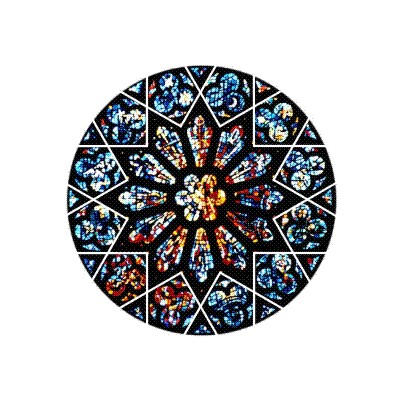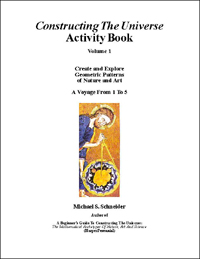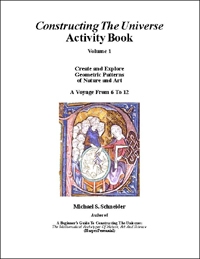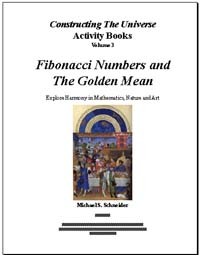

Grace Cathedral is an Episcopal Church in San Francisco, California. It was born of Grace Church which was founded in 1849 during the Gold Rush, and became a cathedral just in time to be destroyed in the Great Earthquake of 1906. Construction of the present structure, in the French Gothic style, was begun in 1928 and finished in 1964. Today, it's the third largest Episcopalian Cathedral in the nation. Grace Cathedral is a living cathedral especially known for its complete involvement serving the diverse San Francisco Bay Area, its "Gates of Paradise" front doors, its indoor and outdoor labryinths, stained glass windows, choirs, a 44-bell carillon and more. Today, it hosts over 3 million visitors each year, but you can also take a virtual tour of it.
I'm always interested in beautiful rose windows, although usually the more ancient ones. In this light, the magnificent East Rose Window at Grace Cathedral caught my eye. As a challenge to myself, I like to see if I can find and understand the geometric schemes underlying them. I've put two analyses from my books on the web: the ancient Rose Window of Chartres Cathedral and the modern one of The Cathedral of St. John the Divine in New York designed by the timeless traditions. So I set out to understand the geometric pattern underlying Grace Cathedral's East Rose Window. It didn't take long to realize -- to my happy surprise -- that it's geometric scheme was exactly the same as that of Chartres Cathedral's Rose Window! And the best part was seeing how they make use of the same plan in different ways.
When I had completed the window's geometric analysis to my satisfaction (which will unfold below) I decided to look into into its origins. I learned that it's the largest window in the Cathedral, made of 3,765 pieces of specially-faceted glass making the entering morning light sparkle, and it has a name: "Canticle Of The Sun", inspired by a poem of the same name by St. Francis of Assisi (San Francisco's patron saint), a song to G-d celebrating life and the glories of nature. The tracery design of the rose window was prepared by Weihe, Frick & Kruse, cathedral completion architects, based on the original design by Lewis Parsons Hobart (1929) with some minor modifications. It was given its abstract, fluid design (in contrast with the solid tracery geometry) and executed by Gabriel Loire of his famed Loire Stained Glass Studios of Chartres, France. It seems to be a happy coincidence that Loire was from the very town whose Cathedral's window shares the same pattern as Grace Cathedral's!
My first realization was that Hobart, its designer, understood the geometry of the Chartres Window, and I wondered if he'd discovered it on his own or had access to a modern living stream of the ancient knowledge that in Medieval times was only passed orally among the members of the building guilds. I assume that he learned it at the École des Beaux-Arts in Paris where he studied.
In any case, the same geometric construction which produces the different Rose Windows of Chartres and Grace Cathedrals begins with a circle and square, symbols of heaven and earth. For Chartres' window, the square begins sitting flat on its bottom. For Grace's (below), the square begins balanced on its corner. The middle picture shows where to open a compass to turn a half-circle, and the final picture shows the four-leafed result of turning four such arcs. Notice that they cross the original (red) circle at twelve equally-spaced points around the it. Twelve-around-a-center is an archetypal form and worldwide symbol appearing in mythologies, religions, amphictyonies, arts, architecture, science and technology.

Let's only consider the twelve points around the circle. Notice (below, left) how they're connected as one form of the dodecagram, a twelvle-pointed star. In the second picture, the central crossings are erased for the Grace Cathedral's window (while for Chartres some inner lines play a further role). Without going into the steps (below, third step), twelve (yellow) circles nestle among the lines, and one (black) circle surrounds them all. This circle shows us the size of the Rose Window of Grace Cathedral. The final, rightmost picture show us how the geometry was used to find the size of the Chartres' Rose Window: the whole circle has been turned 15 degrees, point up, and an equilateral triangle is drawn among the points. The circle inscribed in the triangle, passing through the lower portions of the yellow circles, is the circle that will become the size of the Rose Window at Chartres. The design at Grace Cathedral reveals more of each of these circles.

Finally (below, left) the twelve central crossing points are connected by six straight lines. Right, a red circle is turned tangent to the yellow circles.

This is enough to show us (below, left) the essential eternal geometric armature on which the elements of Grace Cathedral's "Canticle of the Sun" East Rose Window are aligned. At right, for comparison and contrast, is the same (but rotated) geometric grid used differently to compose the North Rose Window of Chartres.

 Chartres
ChartresBelow is a view of part of the geometry, reminiscent of Islamic and other tiling patterns around the world:

Let's look briefly at an important recurring detail in the Grace Rose Window, the clover leaf arrangement of three tangent circles found in each of the twelve yellow circles. Below, a white circle was drawn around one set. This design occurs in stained glass and other windows in churches around the world.

It's a rather simple construction to accomplish (below, left), made by walking the radius of a circle around the circumference to reveal six equally-spaced points connected by three (red) diameters. These six points are connected as shown in the second image. The sizes of the three (yellow) circles are found among their crossing points.

Highlighting the cathedral's entry way are replicas of the original 15th century doors made for the Baptistery of Florence Cathedral (the Duomo) by the Florentine sculptor and bronze craftsman Lorenzo Ghiberti (1378-1455). Grace Cathedral's doors were created by Bruno Bearzi of Florence and installed in 1964. Below are both doors (Grace left, Duomo right) within regular hexagons, showing that they fit in square-root-of-three rectangles (each of which I've halved vertically). This is the same ratio found in the twelve-pointed geometry of the window, hinting that it's integrated within the whole.

Below (left), I've placed a square around the original circle of the geometric construction and overlaid it upon a beautiful photo of the Cathedral's east facade. Now we see the lines of the eternal, invisible geometry from which the solid, visible, translucent Rose Window materialized in its native place. In welcoming intangible but visible light to the Cathedral filtered through its geometric star, the Rose Window becomes the bridge between the eternal and the transitory. Below (right), I've enlarged the geometry so that its innermost circle grows to become the size of the whole window, and lo! The magnified geometry of the window suggests the scheme for much of the whole facade. (We know that we're looking at the Cathedral on a slant.) What only needs to be added are the seemingly identical spaces above and below it. Microcosm and macrocosm resemble one another: as the Rose Window welcomes light, the whole Cathedral welcomes the community.


To see any of these geometric analyses, click on its name:





